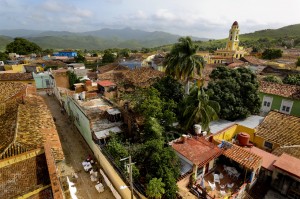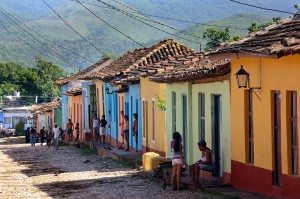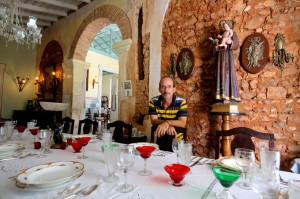Trinidad, colonial city founded 500 years ago symbolizes the strength of private enterprise in Cuba.
Five hundred years after the founding of Trinidad by Diego Velázquez, the best-preserved colonial city in Cuba is experiencing a new renaissance associated with tourism and the growth of private enterprise. The third village founded in Cuba by the Spanish-declared World Heritage Site by UNESCO in 1988 – and left the worst of the crisis of the Special Period, when the town center and the whole island were to collapse after the disappearance of socialist camp. Eliminated this risk, other challenges beset the city of cobbled streets and amazing houses of the eighteenth and nineteenth centuries transported to another time traveler. If Trinidad is famous for its old tiled roofs and eaves brace after their windows blown ending in stylized bars on the street today flourish crowd of family Bs and palates (private restaurants) most extraordinary compete with numerous bars and cafes individual .
In the historic center of Trinidad’s 1,216 homes and buildings of heritage value. And today in the city more than 800 houses rent rooms to foreign and domestic visitors. In addition, about 90 palates offer their services-had just three in 2011 – 81 art galleries are displayed in private homes and hundreds of artisans and self-employed (freelancers) offer their goods in street markets. Surely private in Trinidad has won the game: the tourist can spend a holiday without spending a euro in state property, a paradox in Cuba, where 80% of the economy remains in state hands.
Many owners of private hotels have remodeled their homes with the resources generated by their business
The wealth generated by individuals is not only an important engine of the economy of Trinidad, also has become a key factor for the preservation of the historic center. “Most Trinidadians solve invest in our homes and are aware of the need to preserve the spirit of the city,” explains Mercedes Cano, owner of an impressive eighteenth century house on Calle Hernández Echerri, former Christ, just 20 meters from the Romantic Museum and the Plaza Mayor in Trinidad, where all the buildings are real gems.
Trinidad .. A neighbor after one of the gates that are part of the personality of the colonial city / B. PÉREZ
Some are pretty good, as performed by Manuel Castillo, owner of a hostel that has rescued a courtyard in ruins and has become a spectacular garden. Others are distasteful example-as the owner of a private business that built a Sevillian courtyard and in some cases interventions are an assault on the historical side of Trinidad, the most common is to raise terraces in places that break with the aesthetic locality. This is a serious problem today: money and kitsch taste, which some have dubbed “Miami style” that has permeated many people for obvious reasons. Supports Lazaro Morgado, owner of one of the best palates of Trinidad, Sol Ananda, located in one of the oldest houses in the Real street corner Dodsworth, in the main square, next to the impressive Cantero palace built by Don Mariano Borrell and Padrón 1830 when the nearby valley of the sugar Mills industry became wealthy Trinidadians.
Lazaro shares exist rules of urbanism and conservation that everyone must comply, but said that the Office of the Curator must also adapt to the times and meet the needs of private business owners. “Prohibiting just do not get anything,” he reiterates.
The Curator of the City itself, Norberto Carpio admits that violations are common, “is built at night, on weekends and from back to front of the house.” When you have realized, since the work is done and just have to put a fine.
Uploaded a fabulous palace tower Cantero has a full view of Trinidad. From there you can see the former convent of San Francisco (now the Museum of Struggle Against Bandits) and the palace Brunet (Romantic Museum), two of the properties that the Office of the Curator-rehabilitated by the house and property of Malibran Guaimaro – to mark the 500th anniversary of the city.
Since the height is also seen how some terraces begin to erupt on the sea of old orange tiles Trinidad features arise. And how is beginning to change the physiognomy of the city. “You can not ask people to live as in the eighteenth century and that nothing changes. Must be persuaded, conservation can not be done without the cooperation of the people, “says Garcia Santana, who lives with a mixture of hope and concern what happens. Concern because of the new challenges and is a smart solution soon or Trinidad may soon change. Hope, because once again the city was saved.
In the historic center of Trinidad’s 1,216 homes and buildings of heritage value. And today in the city more than 800 houses rent rooms to foreign and domestic visitors.
The history of Trinidad speaks: after sunset of the sugar industry in the second half of the nineteenth century, the city was isolated and abandoned, so was retained without major changes. In the forties and fifties was a group of intellectuals who founded the Society of Friends of Trinidad to keep their heritage was lost. With the triumph of the revolution, for six years the nearby Escambray mountains were the scene of fighting between the rebel army and rebel groups against Castro, so Trinidad was forgotten again. In the seventies it was the effort of the historian of Trinidad, Carlos Joaquín Zerquera, and others like him who awakened the official sensitivity and the city managed to avoid collapse. Thereafter the State dealt with few resources but with some success of urban preservation.
Walk down any street now Trinidad is like moving to another era. The enduring magic of their past and live with a new reality of small hotels, palates and bars that make city living a new renaissance. Beside The Canchánchara, a typical Trinidadian establishment where drinking and listening to old trova, two new stores representing future danger. One is a palate that operates in an open terrace overlooking the old Trinidadian who has broken tiles and aesthetics of one of the most important streets of the town. On the other side, the state has opened a franchise of La Bodeguita de Enmedio (famous restaurant in Havana) in their quest to compete with private schools.
The initiative has led to protests from the intellectual community of Trinidad, which has rejected as totally alien to the Bodeguita town and a bad example of intervention that undermines the state, which is who is to require individuals to respect the spirit city and comply with regulations. So many Trinitarians believe, also Lazarus and Mercedes Cano, who strive every day to make their businesses thrive. Both, like Alicia Garcia Santana, are aware that if the danger was before the city fell, the challenge today is to get the balance to preserve it.
Agencies/El Pais,Spain, Mauricio Vicent/ Excerpts/Internet photos/Arnoldo Varona/thecubanhistory.com
THE CUBAN HISTORY, HOLLYWOOD.
TRINIDAD, CUBA: EJEMPLO DE LA MAGIA DEL SECTOR PRIVADO.
 La ciudad colonial fundada hace 500 años simboliza la pujanza de la iniciativa privada en Cuba.
La ciudad colonial fundada hace 500 años simboliza la pujanza de la iniciativa privada en Cuba.
Quinientos años después de la fundación de Trinidad por Diego de Velázquez, la ciudad colonial mejor conservada de Cuba experimenta un nuevo renacimiento asociado al turismo y al auge de la iniciativa privada. La tercera villa fundada en Cuba por los españoles —declarada Patrimonio de la Humanidad por la UNESCO en 1988— ya dejó atrás lo peor de la crisis del Periodo Especial, cuando su núcleo urbano y la isla entera estuvieron a punto de colapsar tras la desaparición del campo socialista. Eliminado este riesgo, otros retos acechan a esta ciudad de calles empedradas e increíbles casonas de los siglos XVIII y XIX que transportan al viajero a otra época. Si Trinidad es famosa por sus viejas techumbres de teja y sus aleros de tornapunta, tras sus ventanas voladas que acaban en estilizadas rejas a la calle hoy florecen multitud de hostales familiares y los paladares (restaurantes privados) más extraordinarios compiten con numerosos bares y cafeterías particulares.
En el casco histórico de Trinidad hay 1.216 viviendas e inmuebles de valor patrimonial. Y hoy en la ciudad más de 800 casas alquilan habitaciones a visitantes extranjeros y nacionales. Además, unos 90 paladares ofrecen sus servicios —había tan sólo tres en 2011—, 81 galerías de arte se muestran en casas particulares y cientos de artesanos y cuentapropistas (trabajadores autónomos) ofrecen sus mercancías en mercadillos callejeros. Sin duda, lo privado en Trinidad ha ganado la partida: el turista puede pasar unas vacaciones sin gastar un euro en un establecimiento estatal, toda una paradoja en Cuba, donde el 80% de la economía sigue en manos del Estado.
Muchos dueños de hoteles privados han rehabilitado sus casas con los recursos generados por sus negocios
Esta riqueza generada por los particulares no sólo es un motor importante de la economía de Trinidad, también se ha convertido en un factor clave para la conservación del casco histórico. “La mayoría de los trinitarios invertimos en arreglar nuestras viviendas y somos conscientes de la necesidad de preservar el espíritu de la ciudad”, explica Mercedes Cano, dueña de una impresionante casa del siglo XVIII situada en la calle Hernández Echerri, antigua Cristo, a escasos 20 metros del Museo Romántico y de la plaza Mayor de Trinidad, donde todos los edificios son auténticas joyas.
Algunas están bastante bien, como la realizada por Manuel Castillo, dueño de un hostal que ha rescatado un patio en ruinas y lo ha convertido en un jardín espectacular. Otras son ejemplo de mal gusto —como el del propietario de un negocio privado que construyó un patio sevillano— y en algunos casos las intervenciones son una agresión a la cara histórica de Trinidad —la más común es levantar terrazas en lugares que rompen con la estética de la localidad—. Este es un problema grave hoy: el dinero y un gusto kitsch, que algunos han bautizado como “estilo Miami”, que ha calado en mucha gente por motivos obvios. Lo admite Lázaro Morgado, dueño de uno de las mejores paladares de Trinidad, Sol Ananda, situado en una de las viviendas más antiguas de la calle Real, esquina Desengaño, en la plaza Mayor, al lado del impresionante palacio Cantero construido por Don Mariano Borrell y Padrón en 1830 cuando en el cercano valle de los Ingenios la industria del azúcar hizo ricos a los trinitarios.
Lázaro comparte que existan unas normas de urbanismo y conservación que todo el mundo deba cumplir, pero dice que la Oficina del Conservador también ha de adecuarse a los nuevos tiempos y atender a las necesidades de los dueños de negocios privados. “Prohibiendo sólo no se consigue nada”, reitera.
El propio Conservador de la Ciudad, Norberto Carpio, admite que las violaciones son frecuentes: “Se construye por la noche, los fines de semana y desde atrás de la casa para adelante”. Cuando se han dado cuenta, ya la obra está hecha y sólo queda poner una multa.
Subido a la torre del fabuloso palacio Cantero se tiene una vista completa de Trinidad. Desde allí se ve el antiguo convento de San Francisco (hoy Museo de Lucha contra Bandidos) y el palacio Brunet (el Museo Romántico), dos de los inmuebles que la Oficina del Conservador ha rehabilitado —junto a la casa Malibran y la hacienda de Guaimaro— con motivo del aniversario 500 de la ciudad.
Desde la altura se aprecia también cómo empiezan a surgir algunas terrazas que irrumpen sobre el mar de viejas tejas anaranjadas características de Trinidad. Y cómo empieza a cambiar la fisionomía de la ciudad. “No se puede pedir que la gente viva como en el siglo XVIII y que no cambie nada. Hay que persuadir, la conservación no se puede hacer sin la colaboración de la gente”, afirma García Santana, que vive con una mezcla de esperanza y preocupación lo que sucede. Preocupación, porque ante los nuevos retos o se encuentra pronto una solución inteligente o en poco tiempo Trinidad puede cambiar. Esperanza, porque una vez más la ciudad se ha salvado.
En el casco histórico de Trinidad hay 1.216 viviendas e inmuebles de valor patrimonial. Y hoy en la ciudad más de 800 casas alquilan habitaciones a visitantes extranjeros y nacionales.
La historia de Trinidad habla: después del ocaso de la industria del azúcar, en la segunda mitad del siglo XIX, la ciudad quedó aislada y abandonada, por eso se conservó sin grandes transformaciones. En los años cuarenta y cincuenta fue un grupo de intelectuales el que fundó la Sociedad de Amigos de Trinidad para evitar que se perdiera su patrimonio. Con el triunfo de la revolución, durante seis años las cercanas montañas del Escambray fueron escenario de combates entre el ejército rebelde y grupos alzados en armas contra Castro, por lo que Trinidad nuevamente cayó en el olvido. En los años setenta fue el esfuerzo del historiador de Trinidad, Carlos Joaquín Zerquera, y de otros como él los que despertaron la sensibilidad oficial y lograron evitar que la ciudad colapsara. A partir de entonces el Estado se ocupó, con escasos recursos pero con cierto éxito, de la preservación urbanística.
Pasear hoy por cualquier calle de Trinidad es como trasladarse a otra época. La magia de su pasado perdura y convive con una nueva realidad de hotelitos, paladares y bares que hacen que la ciudad viva un nuevo renacimiento. Al lado de La Canchánchara, un típico establecimiento trinitario donde se bebe y se escucha vieja trova, hay dos nuevos establecimientos que representan los futuros peligros. Uno es un paladar que funciona en una terraza abierta sobre las viejas tejas trinitarias y que ha roto la estética de una de las calles más importantes de la villa. Al otro costado, el Estado ha abierto una franquicia de La Bodeguita de Enmedio (restaurante famoso de La Habana) en su afán por competir con los establecimientos privados.
La iniciativa ha provocado las protestas de la comunidad intelectual de Trinidad, que la ha rechazado por ser la Bodeguita totalmente ajena a la ciudad y ejemplo de una mala intervención que desautoriza al Estado, que es quien ha de exigir a los particulares que respeten el espíritu de la ciudad y cumplan con las regulaciones. Así lo creen muchos trinitarios, también Lázaro y Mercedes Cano, que se afanan cada día para que sus negocios progresen. Ambos, igual que Alicia García Santana, son conscientes de que si antes el peligro era que la ciudad se cayera, hoy el reto es conseguir el equilibrio para preservarla.
Agencies/El Pais,Spain, Mauricio Vicent/ Excerpts/Internet photos/Arnoldo Varona/thecubanhistory.com
THE CUBAN HISTORY, HOLLYWOOD.








